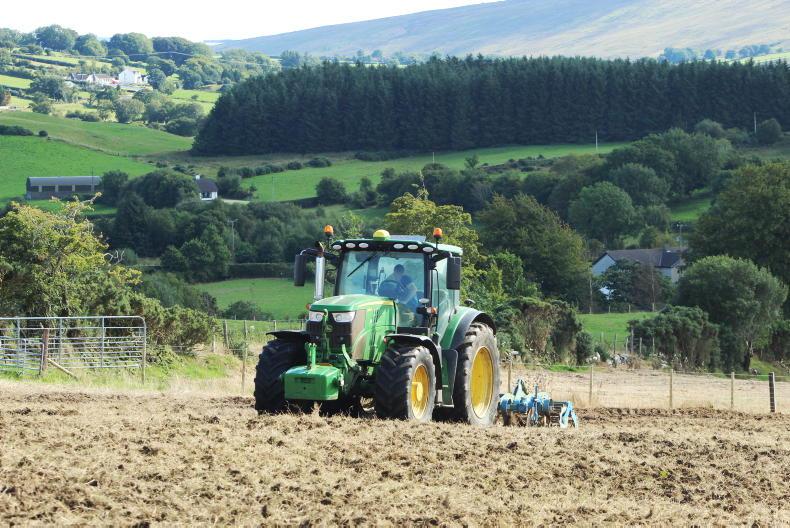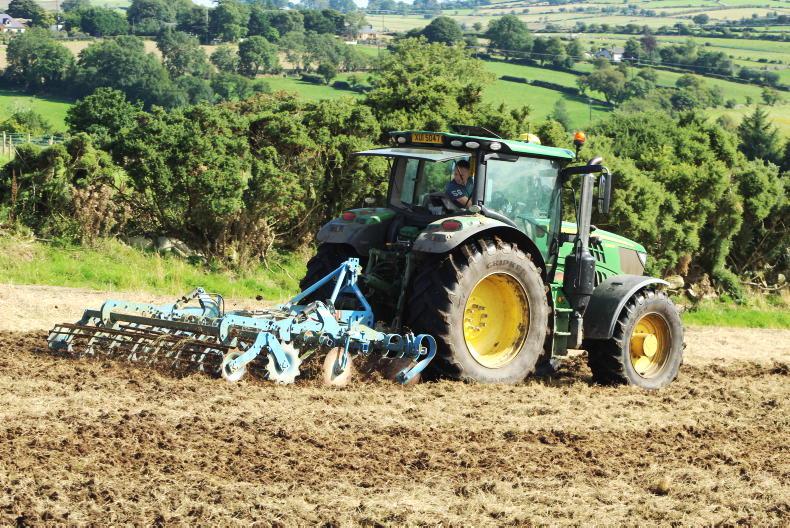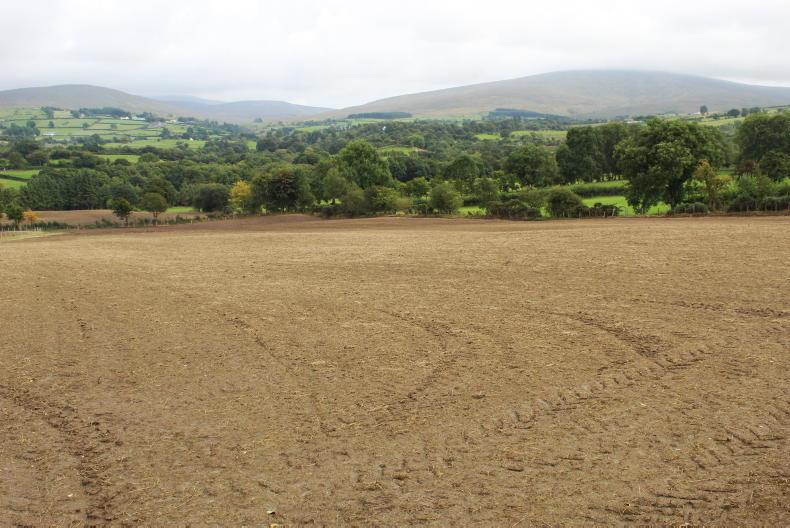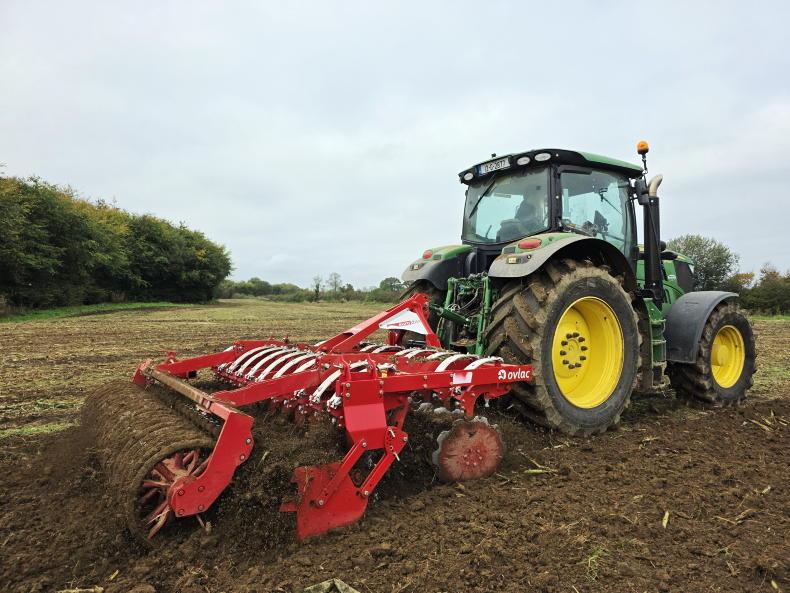Park, Co Derry
As part of his approach to grassland management, Clement Lynch (pictured) has just completed reseeding 9.6 acres of grazing, which lies adjacent to his home yard outside the village of Park, Co Derry.
The farm is an upland and hill unit, nestled within the Sperrin mountains, so reseeding in spring is not an option for a number of reasons.
These include land type, elevation, low spring growth and grazing around the yard being required for ewes post-lambing. Clement opted to burn off the old sward, then establish new grass without ploughing ground. The different stages of the reseeding process are outlined through the series of photos.
Burning off
The old sward was burned off at the end of July with glyphosate. The plan had been to leave the grass to die back for two weeks, then start prepping the field for new grass.
However, cultivating work was delayed until the end of August, by which stage the chemicals applied had given an excellent kill effect.
Preparing the seed bed
Cultivating work got under way on 30 August, with the dead matt of grass from the old sward broken up with one pass of a rotavator using a local agri-contractor.

The 9.6ac field was prepared for reseeding using a heady disc.
This was immediately followed by two runs with a heavy disc to expose more soil, as well as levelling out the seed bed. The field was then rolled to create a tight seed bed.
Prior to sowing grass seed, Clement used another contractor to apply 2.5t/acre of ground limestone to raise soil pH on 1 September.

The field was rolled and received 2.5t/acre of lime after discing.
Soil analysis shows a further lime application is required to raise pH, but the 2.5t/acre was the maximum that could be applied in one dressing without causing soil degradation. Additional lime will be applied next summer.
Grass seed and roll
Grass seed was sown on Friday 2 September. While the earlier cultivation work was completed by a contractor, Clement sowed grass seed by himself.

Grass seed was sown on 2 September.
Grass seed was broadcast at 14kg/acre, with seed spread in two directions by travelling horizontally and vertically across the field. A final rolling helped to increase soil to seed contact.
Grass mix used for reseeding
The grass mix used was selected to suit intensive grazing by sheep. The varieties in the mix include:
2kg Abergreen (PRG).2kg Aberavon (PRG).2kg Aberplentiful (PRG).4kg Aberlee (PRG).1kg Comer (Timothy).2kg Maxima (Red Fescue).1kg Abersheep (white clover). Read more
Factories ‘anxious’ for lambs – IFA
Our favourite farming photos from a wet week
Park, Co Derry
As part of his approach to grassland management, Clement Lynch (pictured) has just completed reseeding 9.6 acres of grazing, which lies adjacent to his home yard outside the village of Park, Co Derry.
The farm is an upland and hill unit, nestled within the Sperrin mountains, so reseeding in spring is not an option for a number of reasons.
These include land type, elevation, low spring growth and grazing around the yard being required for ewes post-lambing. Clement opted to burn off the old sward, then establish new grass without ploughing ground. The different stages of the reseeding process are outlined through the series of photos.
Burning off
The old sward was burned off at the end of July with glyphosate. The plan had been to leave the grass to die back for two weeks, then start prepping the field for new grass.
However, cultivating work was delayed until the end of August, by which stage the chemicals applied had given an excellent kill effect.
Preparing the seed bed
Cultivating work got under way on 30 August, with the dead matt of grass from the old sward broken up with one pass of a rotavator using a local agri-contractor.

The 9.6ac field was prepared for reseeding using a heady disc.
This was immediately followed by two runs with a heavy disc to expose more soil, as well as levelling out the seed bed. The field was then rolled to create a tight seed bed.
Prior to sowing grass seed, Clement used another contractor to apply 2.5t/acre of ground limestone to raise soil pH on 1 September.

The field was rolled and received 2.5t/acre of lime after discing.
Soil analysis shows a further lime application is required to raise pH, but the 2.5t/acre was the maximum that could be applied in one dressing without causing soil degradation. Additional lime will be applied next summer.
Grass seed and roll
Grass seed was sown on Friday 2 September. While the earlier cultivation work was completed by a contractor, Clement sowed grass seed by himself.

Grass seed was sown on 2 September.
Grass seed was broadcast at 14kg/acre, with seed spread in two directions by travelling horizontally and vertically across the field. A final rolling helped to increase soil to seed contact.
Grass mix used for reseeding
The grass mix used was selected to suit intensive grazing by sheep. The varieties in the mix include:
2kg Abergreen (PRG).2kg Aberavon (PRG).2kg Aberplentiful (PRG).4kg Aberlee (PRG).1kg Comer (Timothy).2kg Maxima (Red Fescue).1kg Abersheep (white clover). Read more
Factories ‘anxious’ for lambs – IFA
Our favourite farming photos from a wet week













SHARING OPTIONS